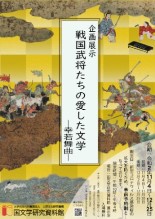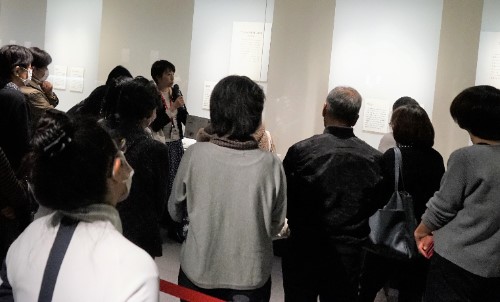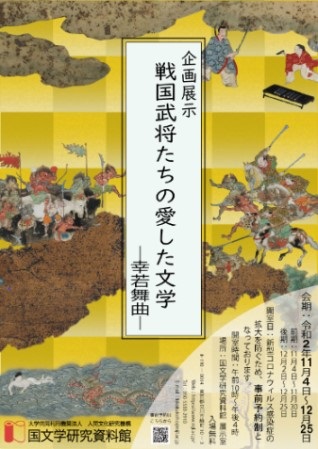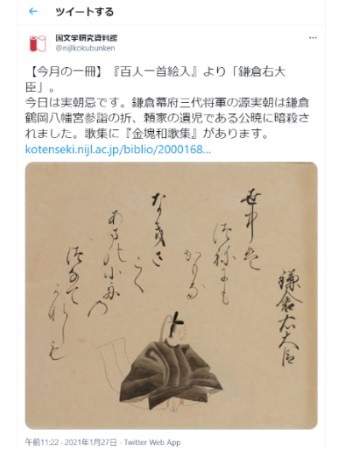COVID-19 and the Future of “Liberal Arts Communication”

The COVID-19 outbreak has brought unprecedented changes to people’s ways of life. With natural history and art museum exhibits postponed or sometimes cancelled, its impact has extended to cultural activities as well. This article looks back on the process that led to the holding of a special exhibition at my initiative during the pandemic period at the National Institute of Japanese Literature (NIJL) and discusses ideas for “liberal arts communication” activities from now on
Liberal Arts Communicator at NIJL
The National Institutes for the Humanities (NIHU) assigns a liberal arts communicator to each of the six research institutes that make up NIHU. I am assigned to the National Institute of Japanese Literature in Tachikawa, Tokyo. My work is diverse, but my main duties are involved with transmitting to society the value and attraction of classical documents of literature through workshops and exhibitions.
Before February 2020, I was actively engaged in gallery talks held every Thursday, picture-scroll (e-maki) making workshops organized by the Nishisuna Library in the city of Tachikawa, public lectures on kuzushiji (classical simplified cursive handwriting) organized by NIJL, and so on. With the spread of COVID-19, however, all such events had to be suspended.
My particular concern is with the state of the exhibition rooms adjacent to the reading room. Before the outbreak of the pandemic, two permanent exhibitions of NIJL collection and four mini-exhibitions were held annually. For the researcher, student of other universities, and adviser of students at NIJL, the exhibition rooms were places where you would naturally go after doing research in the reading room; students often went to the exhibition rooms to examine the works there and faculty members held classes there while viewing the exhibits. Local residents, too, seemed to enter the exhibition rooms as a little-known source of enjoyment. Some became regular visitors interested in the kuzushiji style of writing after attending a public lecture on the subject. They would come to the exhibition rooms to gaze at the documents, determined to decipher the kuzushiji. People also came regularly who really looked forward to the Thursday gallery talks.
However, after the first COVID-19 state of emergency was declared, the exhibition rooms were closed. Even after the lifting of the state of emergency they were opened only three days a week and users were required to make reservations in advance for a time slot. Up to five people were allowed to enter at any one time. The number of visitors has dropped dramatically.

Gallery talk before the COVID-19 outbreak.
The author is the person with the microphone.
Toward Opening of the Special Exhibition
Despite the situation described above, I had an exhibition project that I had been thinking about for some time. It was later materialized in the form of a project exhibition titled “Sengoku bushō-tachi no aishita bungaku: Kōwaka bukyoku” (Recitative Dance Literature of the Sengoku Samurai: Kōwaka-bukyoku), held from November 4 to December 25, 2020. I specialize in Kōwaka-bukyoku, sekkyō, and kojōruri, which are genres of narrative literature popular from the late Muromachi to early Edo period (sixteenth to seventeenth centuries). These are minor genres little known to most Japanese today because they are not introduced in secondary education textbooks of classical literature. When in university I read the Kōwaka-bukyoku piece Shinkyoku (New Music), I was instantly captivated by the fine tempo of the narrative and fascinated by the dilemmas and tumultuous lives of the characters. The ancient literature we had read in our school textbooks was limited to court tales (men and women falling in love with many trysts, tears, and partings) and military tales (filled with fierce men fighting each other). I therefore found very fresh the Kōwaka-bukyoku narratives, which capture the fabric of human relationships familiar to us even today. Eager to share my excitement about this ancient literary tradition, I came up with the idea of holding a special exhibition. As soon as I took my post at NIJL in 2018, I began a survey of the Kōwaka-bukyoku-related documents in the institute’s library.
It was around the autumn of 2019, just before the COVID-19 pandemic, that I heard the exhibition rooms would operate at about half of normal capacity, so I started to prepare by drawing up a list of works to be exhibited and writing explanatory commentaries. The event was initially scheduled to be held for two months from April 27, 2020. The opening was delayed due to the COVID-19 pandemic, and considering the danger of infection spreading, it was decided that the exhibition would be postponed to November 4. The exhibition would be divided into four parts—introduction, popularity, reading, and depiction of Kōwaka-bukyoku. It would introduce in easy-to-understand language how the genre came into being and gradually evolved, as well as provide a summary of each of the Kōwaka-bukyoku pieces on display. The main works shown were old documents with illustrations that even non-specialist visitors could enjoy. (For details, see Kokubunken News, No. 58)

Leaflet made by NIJL staff
Holding of the Exhibition
Due to the second wave of COVID-19 that peaked around August 7, 2020, we thought of holding the exhibition online only, but toward the end of the summer the pandemic seemed to come under control, and we decided to open the galleries. We did commission a professional company to install exhibits, but there were difficulties in getting funds allocated on short notice when plans could not be worked out sufficiently in advance, so I created the leaflets and panel texts in the NIJL offices with the cooperation of the publicity staff.
The exhibition opened on November 4, but for a while it had few visitors. Thanks to the active efforts of NIJL faculty members to make the exhibition known, reservations to attend the exhibition began increasing in December. Many of them were made by people of my acquaintance. I also received requests to do gallery talks to be held alongside the exhibition.
The questionnaire response rate rose as well. Before the COVID-19 outbreak response rates from the exhibition rooms visitors had been low; admission was free and there was no staff member on site to distribute and collect them. The newly adopted reservation system due to COVID-19 allowed us to ask almost all visitors to answer the questionnaire. Visitors could not enter or leave the room as freely as before, but we were able to take advantage of this adversity and use it to find a better way of operating the galleries. In their questionnaires some visitors said the reservation system allowed them to take their time in appreciating the exhibition.

Gallery talk for student visitors
Liberal Arts Communication Amid COVID-19
From the beginning of the exhibition COVID-19 restrictions made it difficult to maintain the free and casual atmosphere that had once been possible in the exhibition rooms. Wanting something to compensate for that loss, I began thinking it necessary for the time being to develop online content that could be appreciated at home. The first step was to make accessible, from among the list of the exhibited works, those images that are publicly available through a NIJL database (Database of Pre-Modern Japanese Works).
It was at a time when many museums were providing online videos of gallery talks to convey the attraction of their exhibitions. Using these as reference, and with the aid of Associate Professor Kitamura Keiko in charge of the online exhibition, I created a gallery talk video (now in the finalization process). I could not make it in time for transmission of the video during the exhibition period, but it will be available sometime soon on the NIJL website for those who were not able to visit the exhibition.
Accompanying commentaries for all the works on display could not be prepared by the opening. I continued writing the commentaries even after the opening and gradually increased their number, so it did have something of a homemade look. The exhibit attracted, however, as many as 95 visitors, more than usual. Of the 29 questionnaire responses collected, 25 indicated satisfaction. As it turned out, the exhibition was held through to the last day without having to be suspended midway due to the worsening of the pandemic. Even so, I feel there were more things I could have done, such as transmitting its highlights via Twitter.
Most regrettable of all was that a catalogue could not be created and published for the exhibition. Some respondents to the questionnaire said in the comment space that “It’s too bad that there was no exhibition catalogue, which would have allowed us to enjoy the exhibition again at home. (It’s too bad especially for people who don’t have a smartphone or iPad),” and “A catalogue would have made the exhibition even more satisfying.” There is a limit to what one person can do, but I do hope that publication of a catalogue will eventually be possible.
The questionnaire responses were positive about even such a rare theme as Kōwaka-bukyoku, commenting, for example, that “Holding an exhibition on such an unusual theme is itself really good,” or “I’ve learned a lot about Kōwaka-bukyoku, which was totally unknown to me.”
Liberal Arts Communication from Now On
Due to the COVID-19 pandemic, the exhibition was held in a very different way than before. It nevertheless provided a good opportunity to take a fresh look at liberal arts communication, which had previously been bound by face-to-face communication. Regardless of whether face-to-face or not, there is great diversity in ways of communication and they all offer chances for productive encounter. Face-to-face gallery talks are not the only way to communicate. There is also non-face-to-face communication through social media such as Twitter. Ways may be devised so that an exhibition can be enjoyed alone such as at home. We might be wrong to think that museums are the best venues for acquiring knowledge [through exhibitions].
How to enjoy a museum exhibition varies from person to person. Some people do not really go to see the works on display so much as to enjoy browsing in the museum shop or relaxing at the museum café. Because of the pandemic, restrictions are being applied to admission to museum buildings and galleries are not easily accessible. By using online content and videos, I’m trying to find ways of transmitting the attraction of classical literature and restoring something like the relaxing atmosphere to be found in an exhibition rooms.

Twitter series “[Recommended] Book for the Month,” introducing classical documents in connection with traditional annual events
Text: Kume Shiori, Liberal Arts Communicator National Institute of Japanese Literature
